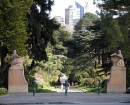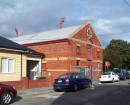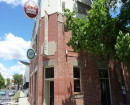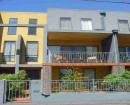MIRBOO ON TARWIN HALL
285 MIRBOO SOUTH ROAD MIRBOO, SOUTH GIPPSLAND SHIRE
-
Add to tour
You must log in to do that.
-
Share
-
Shortlist place
You must log in to do that.
- Download report












Statement of Significance
What is significant?
The Mirboo on Tarwin Hall was constructed as the Mirboo Mechanics Institute and Free Library in 1928 and opened in January 1929. The Hall was designed by Leongatha architect, TE Molloy, who also designed a number of other public buildings in the shire. The major part of the social life of the district revolved around the Mechanics Institute, which with its associated library and billiard room, was the only suitable venue for public functions in the township. The hall was used for balls, concerts, meetings, magistrate's court proceedings, and the screening of motion pictures by an itinerant projectionist every fortnight.
The Mirboo on Tarwin Hall adopts a common layout for halls with a rectangular auditorium fronted by two smaller rooms symmetrically arranged on either side ofthe entrance. The bio box over the entrance is also characteristic of halls built after the introduction of cinema. The material pallette, roof solution and detailing of the hall, however, display an idiosyncratic and unusual integration of rural, domestic and industrial influences. The auditorium roof is based on a three centred arch curve, and is formed from curved corrugated iron on steel angle trusses and purlins, with prominent industrial skylight ventilators. The front room roofs are more domestic gables decorated with acroteria formed from sheet metal. Iron framed windows are used on the front facade at ground level, with a baroque headed window to the bio box. The walls are of asbestos cement with weatherboards in the gables and a strip along the top of the side walls of the auditorium - a reversal of the bungalow convention of the day. The side walls were originally windowless. The internal decorations, including an Egyptian influenced proscenium opening, are a mixture of domestic plaster details with the addition of sheet metal features.
How is it significant?
The Mirboo on Tarwin Hall is historically significant as a representative example of a mechanics institute and free library which was the centre of cultural and social activity for its small community.
Why is it significant?
The Mirboo on Tarwin Hall is historically significant as a representative example of a community hall used for the projection of motion pictures in the mid- twentieth century.
The Mirboo on Tarwin Hall is architecturally significant as an unusual, distinctive and idiosyncratic design which was nonetheless a successful and fitting solution when it was built. The building used readily available, portable and economical materials and was straightforward to construct. This design sensibility reflected the ethos of the small farming community who participated in its design and construction.
-
-
MIRBOO ON TARWIN HALL - History
Mirboo on Tarwin Hall (Former Mirboo Mechanics Institute and Free Library)
CONTEXTUAL HISTORY
The settlement of Gippsland
Gippsland prior to the 1870s was very sparsely occupied. Its settlement was boosted dramatically in the 1870s by large numbers of settlers taking up land in response to the Selection Acts. The legend of the selector taming nature by cutting down the giant forest trees to carve out a dairy farm became a dominant theme in Gippsland lore. Some who took up land in south and west Gippsland had moved from Ballarat and other mining towns after the alluvial gold ran out. The Mirboo district was settled first around 1875 when selectors moved along the Sale road from Warragul to Trafalgar and Moe and then found their way south into the hills. This movement extended through to Mirboo and Mirboo North. The settlers developed a mixed rural economy – timber, coal, dairying, berries and vegetables. (Patrick Morgan The Settling of Gippsland. Traralgon, Vic., Gippsland Municipalities Association, 1997. Pp. 109-10) Schools had opened in the Mirboo district by the early 1880s. (Warwick Eunson. The Unfolding Hills: Mirboo Pioneers of the Gippsland Forests 1878-1914, p. 43, 47)
Mirboo
Two towns called Mirboo were established. The township of Mirboo, later called Mirboo on Tarwin, in the Parish of Mirboo South was surveyed south of the Tarwin East River in October 1878. Another township also known as Mirboo was surveyed in 1880, located on the ridge, but this was generally known as Brennan’s Corner, where about ten allotments were surveyed. Twenty two allotments, each of two acres were surveyed in Mirboo on Tarwin and provision was made in the 1878 survey for eight acres of recreational areas, including a mechanics institute reserve of two acres. A mechanics institute and free library was established early in 1887. (Eunson, p. 56-7)
The Railway
Two settlements eventually combined to form the present Mirboo North. Baromi was the nucleus of a town which failed to develop in the nineteenth century, east of The Terminus. This township did not develop as expected, largely because of the railway going through the present Mirboo North, and a newspaper referred to Mirboo North (Baromi) as ‘ a town that never was’. (Eunson, p. 23). A railway line from Morwell to Mirboo was completed in 1886. The town of Mirboo North was established as a result of the railway that was built as a branch line from Morwell during 1883-84. The link was intended to go to Baromi but the only suitable site for a railway station was found about a mile and a half west of Baromi. This site was at first called The Terminus, and later became known as Mirboo North. (Thematic History South Gippsland Heritage Study. P. 45) The 32 kilometre line was closed in 1974. The choice of Mirboo North as the railway terminus also restricted the growth of the settlement at Mirboo on Tarwin, which gradually lost population and by 1974 had lost its few public buildings.
Mechanics Institutes and Community Halls
One of the first requirements in a new settlement was a public meeting hall for social, religious and civic functions.. When new townships were surveyed, a centrally located piece of land was normally allotted for the building of a public hall or a Mechanics Institute.
(John Murphy ’Introduction’, Pam Baragwanath. If the Walls Could Speak: A Social History of the Mechanics Institutes of Victoria. Melbourne, 2000.)
The Victorian government provided a small annual subsidy towards the cost and maintenance of Mechanics Institute libraries. A Free Library existed at Mirboo from 1887 (Eunson, pp.56-7)/.
Mechanics Institutes were often simple structures of timber and corrugated iron; but their importance to the community was considerable and they were usually built as a result of community effort and commitment.. They were used by the various denominations for church services, Sunday school, bazaars, meetings and concerts. Rooms were often hired out for Courts of Petty Sessions, Land Courts, Shire Council meetings, itinerant music teachers and other visiting professional people. The main hall was in demand for dances, balls, political meetings and debates, auctions, weddings, roller-skating, concerts and various visiting entertainers. Magic lantern shows were popular about the time of the Boer War and towards the end of the First World War, the halls were used for the screening of motion pictures. A pianist was employed to play the accompaniment to the early silent films. A library and reading room was an important part of the Mechanics Institute, to keep community members in touch with news from abroad, and from the capital cities by the provision of journals and newspapers, to give them access to information on a wide variety of subjects and to encourage reading and further education. (Baragwanath, p. xii, 4)
History of Cinema
Motion pictures reached Australia in 1896. After a slow start, "the pictures" rapidly became the most popular entertainment in the country. In the 1920s, it was estimated that in a total population of just over six million in Australia, there were two and a quarter million picture-show admissions each week. By 1921, the picture show made the largest contribution to Entertainment Tax receipts with more than 68 million admissions. (Diane Collins. Hollywood Down Under: Australians at the Movies. North Ryde, NSW, Angus & Robertson, 1987, p. 3, 17, )
The first picture theatres were open-air shows or tent cinemas. Between approximately 1908 and the end of World War I, weatherboard, corrugated iron and brick structures gradually appeared in every suburb, town and city. By the late 1920s Union Theatres and Hoyts had constructed chains of luxurious American-style picture palaces in the capital cities and a few large country towns. But most country patrons living in or near small country towns watched the pictures in their local hall. Since the projection equipment was portable, it could be taken from town to town. Itinerant exhibitors brought films to smaller towns, moving from town to town on a regular circuit.
HISTORY OF PLACE
The land on which the Mirboo on Tarwin Hall stands was first reserved for a Mechanics Institute and Free Library in the township survey for Mirboo, which was carried out in 1879. The first hall on the site was constructed in 1887 and was subsequently moved to Dunbalk North. The original site and building is associated with George Goldsmith, local storekeeper, who took up land with his sons at Mirboo on Tarwin in 1878 and conducted a store in the settlement. His sons took up selections six miles down the river. .In 1885, he built the Belle Vue hotel and store in Mirboo close to the Tarwin, benefiting from the trade coming from a river crossing. Goldsmith was active in the community, supporting the provision of tramways to improve transport and the promotion of a Mechanics Institute for community education and entertainment.
The hall was constructed as a result of community support. It was used as a school from 1890 to 1893. The second hall was opened on 18 September 1905 but this was destroyed by fire on 27 September 1927.A committee quickly raised £1000 towards the building of a new hall. (John Murphy. On the Ridge: The Shire of Mirboo 1894-1994.St Leonards, NSW, Allen & Unwin, 1994. p.186). The Mirboo Mechanics Institute and Free Library was opened in January 1929.
The Mirboo on Tarwin Hall was designed by Leongatha architect, T. E. Molloy, who also designed a number of other public buildings in the shire. Extant examples include the Leongatha Memorial Hall and Shire Offices (1926), the Leongatha Catholic Church Hall (1927), the Fish Creek Public Hall (1930) and the Marden South Anglican Church (1934). The final cost of the building was £1930 which included electric lighting from it own generator. (Murphy, p. 187)
A concert was arranged for the official opening in January 1929 at which visiting artists from Melbourne performed. A ball to mark the occasion followed the concert. The major part of the social life of the district revolved around the Mechanics Institute, which with its associated library and billiard room, was the only suitable venue for public functions in the township. The Crown Law Department leased a room one day per month for magistrate’s court proceedings. This room doubled as a ladies’ dressing room at balls and dances.
Motion pictures were shown every fortnight. The committee agreed to the installation of a sound on film plant to screen talking pictures in December 1931. .Messrs Pincini and Wethensen began regular screenings of pictures in December 1932, paying the committee a rent of 30 shillings a night. (Murphy, p. 192)
The Hall was used from 1929 to 1974 as the centre of social activities in Mirboo.
In October 1974 the Mirboo on Tarwin Hall was sold by its trustees to Mr Jim Darwin. A farewell function was held in November 1974. A sporting pavilion in the Recreation Reserve now serves as a meeting place for Mirboo residents and replaced the amenities provided by the Hall, the hotel and the school. (Murphy, p. 300-1)
MIRBOO ON TARWIN HALL - Permit Exemptions
General Exemptions:General exemptions apply to all places and objects included in the Victorian Heritage Register (VHR). General exemptions have been designed to allow everyday activities, maintenance and changes to your property, which don’t harm its cultural heritage significance, to proceed without the need to obtain approvals under the Heritage Act 2017.Places of worship: In some circumstances, you can alter a place of worship to accommodate religious practices without a permit, but you must notify the Executive Director of Heritage Victoria before you start the works or activities at least 20 business days before the works or activities are to commence.Subdivision/consolidation: Permit exemptions exist for some subdivisions and consolidations. If the subdivision or consolidation is in accordance with a planning permit granted under Part 4 of the Planning and Environment Act 1987 and the application for the planning permit was referred to the Executive Director of Heritage Victoria as a determining referral authority, a permit is not required.Specific exemptions may also apply to your registered place or object. If applicable, these are listed below. Specific exemptions are tailored to the conservation and management needs of an individual registered place or object and set out works and activities that are exempt from the requirements of a permit. Specific exemptions prevail if they conflict with general exemptions. Find out more about heritage permit exemptions here.Specific Exemptions:General Conditions: 1. All exempted alterations are to be planned and carried out in a manner which prevents damage to the fabric of the registered place or object. General Conditions: 2. Should it become apparent during further inspection or the carrying out of alterations that original or previously hidden or inaccessible details of the place or object are revealed which relate to the significance of the place or object, then the exemption covering such alteration shall cease and the Executive Director shall be notified as soon as possible. General Conditions: 3. If there is a conservation policy and plan approved by the Executive Director, all works shall be in accordance with it. General Conditions: 4. Nothing in this declaration prevents the Executive Director from amending or rescinding all or any of the permit exemptions. General Conditions: 5. Nothing in this declaration exempts owners or their agents from the responsibility to seek relevant planning or building permits from the responsible authority where applicable.Registered Building:
* Repairs and maintenance which replace like with like
* Replacement of damaged or missing asbestos cement elements with fibrous cement material of the same dimension (this does not exempt the owner from requirements under other Acts and Standards for safe removal and disposal of hazardous materials)
* Painting of previously painted surfaces in the same or original colour provided that preparation or painting does not remove evidence of the original paint or other decorative scheme
* Removal of paint from originally unpainted or oiled joinery, doors, architraves, skirtings and decorative strapping.
* Treatments to stabilise and protect timber structures
* Removal of existing external aerials, air conditioning, heating and water heating plant, plumbing and ducting
* Refurbishment of existing toilets, bathrooms and kitchens including removal, installation or replacement of sanitary fixtures and associated piping, mirrors, wall and floor coverings
* Installation, removal or replacement of electrical wiring provided that all new wiring is fully concealed and any original light switches, pull cords, push buttons or power outlets are retained in-situ
* Installation, removal or replace of bulk insulation in the roof space
* Installation, removal or replacement of smoke detectors, sprinkler systems and exit signs
Landscape:
* The replanting of plant species to conserve the landscape character
* Management of trees in accordance with Australian Standard; Pruning of amenity trees AS 4373
* Removal of plants listed as Noxious Weeds in the Catchment and Land Protection Act 1994
* Repairs, conservation and maintenance to hard landscape elements, asphalt and gravel paths and roadways, rock edging, fences and gates
* Installation, removal or replacement of garden watering and drainage systems
MIRBOO ON TARWIN HALL - Permit Exemption Policy
The Mirboo on Tarwin Hall is of an age that repair works are increasingly required to elements such as the curved iron roofing, roof plumbing, barge boards and steel front window frames. Most of these works would be possible under the exemption fro replacement of like with like. A permit application will be required for repairs where different materials are substituted for old (apart from replacement of asbestos cement with fibrous cement). A permit application will be required for changes such as partitioning of the internal space, creation of new openings in the walls, additions of new rooms or building of new structures on the site.
-
-
-
-
-
MIRBOO ON TARWIN HALL
 Victorian Heritage Register H1973
Victorian Heritage Register H1973
-
'YARROLA'
 Boroondara City
Boroondara City -
1 Bradford Avenue
 Boroondara City
Boroondara City
-
-
Notes See all notes
Rebecca Harrison • 01/04/20
My mum lived in this area when she was younger for a while. She has so many memories of this hall, I love hearing the stories.
Public contributions
Notes See all notes
Rebecca Harrison • 01/04/20
My mum lived in this area when she was younger for a while. She has so many memories of this hall, I love hearing the stories.










